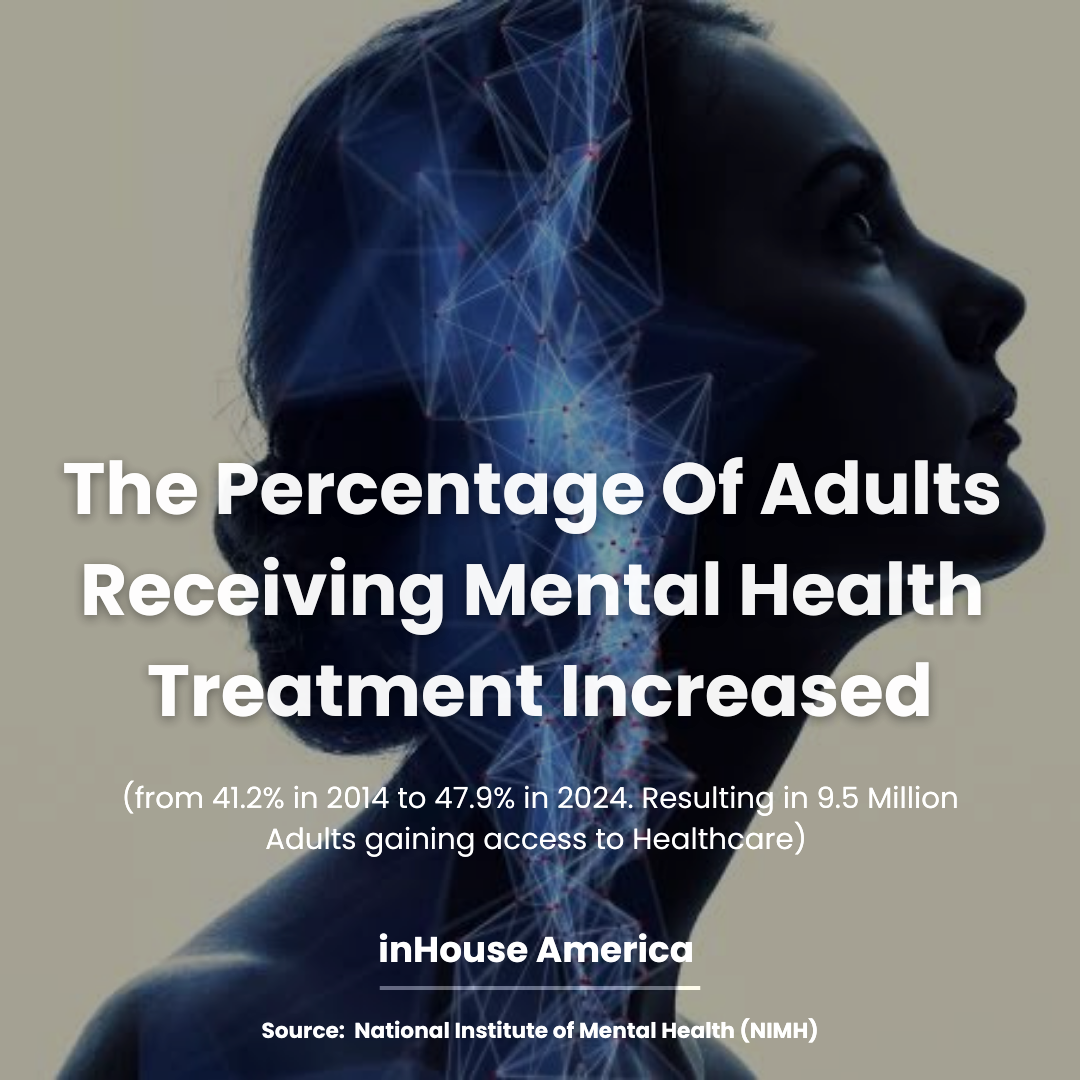InHouse America
Mental Health Treatment Access Rises to 48% of U.S. Adults
Published: 18:20 pm (GMT-5), Wed September 4, 2024
3 Minute Read

Source: (National Institute of Mental Health (NIMH))
Increased Access to Mental Health Care
(Growth in Treatment Rates 2014 - 2024)
The percentage of adults receiving mental health treatment increased from 41.2% in 2014 to 47.9% in 2024.
Source: (National Institute of Mental Health (NIMH))
Insights: This equates to an additional 9.5 million adults accessing treatment by 2024.
(Expansion of Telehealth Services: 2014 - 2024 )
Telehealth services for mental health expanded significantly, with usage growing by 45% from 2020 to 2024 due to the COVID-19 pandemic and subsequent policy changes.
Source: (American Psychological Association (APA))
Insights: This increased access particularly benefited rural and underserved populations, providing care to an additional 6 million people.
Decreased Stigma Around Mental Health
(Increased Public Awareness 2014 - 2024)
Public awareness campaigns and mental health education have led to a 35% reduction in stigma related to mental health issues from 2014 to 2024.
Source: (Mental Health America (MHA))
Insights: More people are seeking help, with a 20% increase in self-reported willingness to seek treatment among young adults.
Workplace Mental Health Initiatives
(Adoption of Workplace Mental Health Programs 2014 - 2024)
75% of large companies implemented mental health programs by 2024, up from 45% in 2014.
Source: (Society for Human Resource Management (SHRM))
Insights: These programs led to a 15% reduction in absenteeism and a 20% improvement in employee productivity, benefiting around 45 million workers.
Rising Mental Health Disorder Prevalence
(Increase in Anxiety and Depression 2014 - 2024)
The prevalence of anxiety disorders rose from 19% in 2014 to 24% in 2024, affecting 1 in 4 adults by 2024.
Source: (National Institute of Mental Health (NIMH))
Insights: Depression rates also increased, from 6.7% to 8.2%, representing an additional 4.3 million adults.
(Youth Mental Health Crisis 2014 - 2024)
The percentage of adolescents experiencing major depressive episodes increased from 11.5% in 2014 to 15.7% in 2024.
Source: (Centers for Disease Control and Prevention (CDC))
Insights: Suicide rates among youth aged 15-24 increased by 33% during this period.
Economic Impact of Mental Health Disorders
(Increased Economic Burden 2014 - 2024)
The economic cost of mental health disorders rose by $150 billion, from $210 billion in 2014 to $360 billion in 2024.
Source: (National Alliance on Mental Illness (NAMI))
Insights: This includes direct costs such as treatment and indirect costs like lost productivity, with depression alone accounting for $120 billion of this total by 2024.
(Shortage of Mental Health Professionals 2014 - 2024)
Despite increased demand, there was a 12% shortfall in the number of mental health professionals needed to meet demand in 2024, leading to longer wait times and reduced access for millions.
Source: (Health Resources and Services Administration (HRSA))
Impact of Social Media on Mental Health
(Negative Effects on Youth 2014 - 2024)
Social media usage has been linked to a 30% increase in anxiety and depression symptoms among adolescents from 2014 to 2024.
Source: (American Academy of Pediatrics (AAP))
Insights: The prevalence of cyberbullying increased by 20%, affecting 16% of all teens by 2024.
InHouse America Support
At InHouse America, we understand the critical role mental health plays in business success. With 20.6% of U.S. adults experiencing mental health issues and 48% receiving treatment, supporting mental well-being is essential for thriving businesses.
Source: (Society for Human Resource Management)
Insights: Companies that invest in mental health see a 15% drop in absenteeism and a 20% boost in productivity, impacting around 45 million workers.
InHouse America doesn't endorse anyone but focuses on creating awareness of the importance of supporting small businesses and which administration is best for doing so!